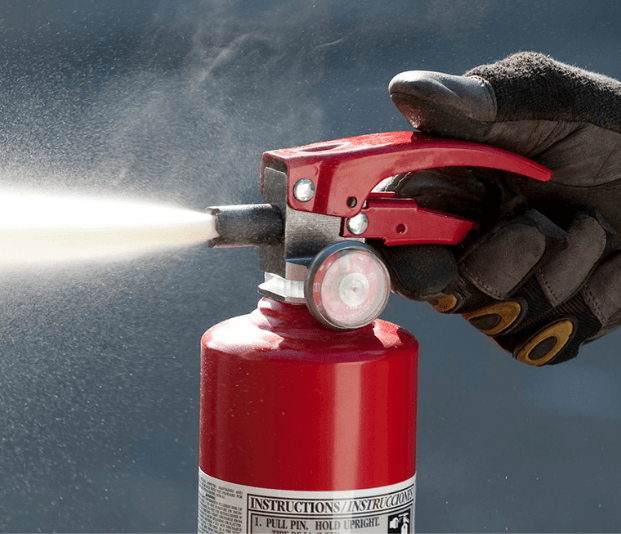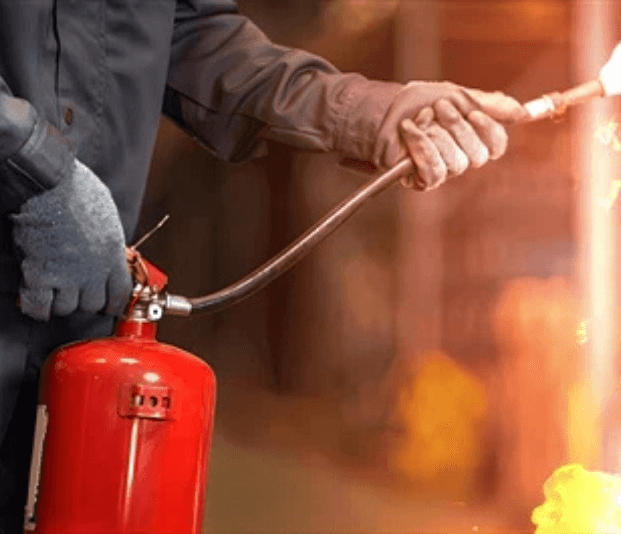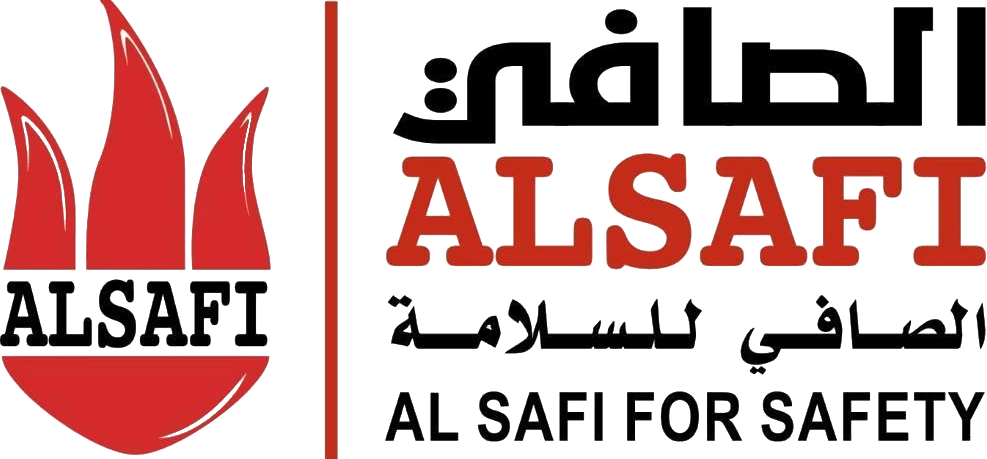المدونة
دليلك لاختيار انواع طفايات الحريق واستخداماتها

هناك الكثير من انواع طفايات الحريق لذا قد يكون اختيار طفاية حريق مناسبة عامل حاسم في إخماد الحريق سريعًا وحماية الأرواح والممتلكات من الأضرار؛ حيث تُعتبر طفايات الحريق من أهم ادوات السلامة التي يجب توفرها في كل منزل ومنشأة، وتتعدد أنواعها لتلائم أنواع الحرائق المختلفة.
في هذا المقال، سنوضح لكم انواع طفايات الحريق واستخداماتها، مع نصائح حول صيانة طفايات الحريق، الأسعار، وأفضل أماكن الشراء لضمان الاستعداد لأي أمر طارئ.
كيف تعمل طفايات حريق؟
يعتمد عمل طفايات حريق على مبدأ إطلاق مادة مثبطة للاحتراق؛ إذ أنها تحتوي على مواد كيميائية خاصة، أو مواد غير قابلة للاشتعال؛ مثل: الرغوة، أو الماء، أو ثاني أكسيد الكربون، والتي تخفض درجة حرارة النار، أو تُقلل كمية الأكسجين اللازمة للاشتعال.
وعند استخدام طفاية الحريق، يتم توجيه الفوهة الخاصة بها نحو قاعدة اللهب؛ للسماح بتطبيق المادة المثبطة على مصدر النار بشكل مباشر، ويعتمد نجاح عملية الإطفاء على كل من نوع المادة المستخدمة في الإطفاء، ونوع الحريق نفسه؛ لذلك يُعد فهم طريقة عمل أنواع طفايات الحريق بمثابة خطوة أساسية لضمان استخدامها بصورة صحيحة.
تستطيع الاتصال بنا على شركة الصافي للحصول على أفضل النصائح حول كيفية عمل طفايات الحريق وأيضا كيف يمكنك استخدامها .
مكونات طفاية حريق
تتكون طفاية حريق من أجزاء رئيسية متعددة تقوم بدور مهم في عملها، ويُساعد فهم هذه الأجزاء على استخدام مطفأة الحريق بصورة صحيحة، وصيانة طفايات الحريق بشكل دوري كذلك، وفيما يلي نوضح لك هذه الأجزاء كالتالي:
- الأسطوانة: تُعد الأسطوانة هي الجزء الرئيسي الذي يحتوي على المادة المثبطة للحريق.
- الصمام: يتحكم هذا الجزء بتدفق المادة المثبطة للنار عند الضغط عليه.
- الفوهة: تقوم بتوجيه المادة المثبطة نحو قاعدة النار.
- المؤشر: يُظهر المؤشر حالة طفاية الحريق؛ لتحديد ما إذا كانت في حالة جاهزية.
- مقبض الحمل: يُسهل حمل طفاية الحريق أثناء استخدامها.
أنواع الحرائق
تُصنف الحرائق لعدة فئات بناءً على المادة المشتعلة، ويُسهم فهم هذه الأنواع في اختيار طفاية الحريق المناسبة لمكافحة كل نوع من أنواع الحرائق:
- الحرائق من النوع A: تتعلق هذه الحرائق بالمواد الصلبة؛ مثل: القمامة، والخشب، والورق.
- الحرائق من النوع B: تشمل السوائل القابلة للاشتعال مثل الزيوت والبنزين.
- الحرائق من النوع C: تتعلق هذه الحرائق بالمواد الغازية مثل الميثان والبروبان.
- الحرائق من النوع D: تشمل المعادن القابلة للاشتعال مثل الماغنيسيوم والصوديوم.
- الحرائق من النوع K: تتعلق بالشحوم والزيوت المُستخدمة بالطهي، وغالبًا ما تحدث هذه الحرائق بالمطابخ التجارية.
اختيار المقاسات المناسبة لطفاية الحريق
يعتمد اختيار المقاس المناسب لكل نوع من طفايات الحريق على العديد من العوامل، ومن هذه العوامل ما يلي:
- حجم المكان: كلما ازداد حجم المكان، كلما ازدادت الحاجة لطفايات أكبر أو عدد طفايات أكثر.
- نوع النشاط: تتطلب بعض الأنشطة طفايات خاصة، مثل المطابخ التي تحتاج لطفايات للزيوت.
- العدد المتوقع للأشخاص: في الأماكن التي يتواجد بها عدد كبير من الأشخاص، لابد وأن تكون الطفايات كافية لتغطية كافة المناطق.
و إذا كنت ترغب في الحصول على اي مساعدة لاختيار المقاس المناسب حسب احتياجاتك تواصل معنا على شركة الصافي لأنظمة الأمن والسلامة
انواع طفايات الحريق واستخداماتها

كما وضحنا فيما سبق أن انواع طفايات الحريق مُتعددة؛ حيث يعتمد كل منها على نوع المادة المشتعلة، وتختلف أجهزة الاطفاء في مزاياها وعيوبها، لذا؛ سنوضح لكم الآن أهم أنواع الطفايات واستخداماتها:
طفايات الماء
- الاستخدام: صُممت خصيصًا لإطفاء الحرائق التي تنشب في المواد الصلبة؛ مثل: (الورق، الخشب، والأقمشة).
- المزايا: تتميز بسهولة استخدامها وتكلفتها المنخفضة؛ حيث تعمل عبر تبريد النيران.
- العيوب: غير ملائمة للاستخدام في الحرائق الكهربائية أو الناتجة عن الزيوت؛ مما يجعل استخدامها محدودًا.
طفايات الرغوة
- الاستخدام: مخصصة للتعامل مع الحرائق الناتجة عن السوائل القابلة للاشتعال؛ مثل: (البنزين، والزيوت).
- المزايا: فعالة في تكوين طبقة رغوية تمنع الأكسجين من الوصول إلى الحريق؛ مما يمنع اشتعاله مجددًا.
- العيوب: غير مناسبة للحرائق الكهربائية، مما قد يحد من استخدامها في بعض الحالات.
طفايات ثاني أكسيد الكربون (CO₂)
- الاستخدام: استخدام طفاية الحريق co2 بشكل خاص في الحرائق الكهربائية، وكذلك حرائق السوائل القابلة للاشتعال.
- المزايا: فعالة وسريعة، وتطفئ النيران دون ترك أي بقايا؛ مما يجعلها مثالية للمناطق الداخلية والأجهزة الإلكترونية.
- العيوب: نطاق فعاليتها قصير، وغير مناسبة لإطفاء حرائق المواد الصلبة.
طفايات المسحوق الجاف
- الاستخدام: طفاية متعددة الاستخدامات، ملائمة للحرائق التي تشمل مواد صلبة أو سوائل أو غازات.
- المزايا: مناسبة لمختلف البيئات والحرائق، وتوفر حماية شاملة في حالات الحريق المتنوعة.
- العيوب: تترك بقايا مسحوق؛ مما قد يتطلب تنظيف دقيق بعد الاستخدام.
طفايات المواد الكيميائية الرطبة
- الاستخدام: صُممت خصيصًا للتعامل مع الحرائق الناتجة عن زيوت الطهي والشحوم؛ مما يجعلها مثالية للمطابخ.
- المزايا: فعالة في منع اشتعال الزيت مجددًا وتضمن إخماد الحريق بشكل آمن وسريع.
- العيوب: غير ملائمة للحرائق الكهربائية أو الحرائق التي تنشب في المواد الصلبة؛ مما يحصر استخدامها في المطابخ بشكل رئيسي.
اختيار الطفاية الصحيحة يمكن أن يصنع فارقًا كبيرًا في إخماد الحريق بفعالية وأمان، اتصل بنا الآن وأحصل على أفضل انواع طفايات الحريق المناسبة لمكانك بسعر مميز للغاية.
كيفية استخدام طفاية الحريق وانواعها؟
لاستخدام طفايات الحريق بشكل صحيح، يجب اتباع بعض الخطوات الأساسية لضمان إطفاء الحريق بفعالية وسرعة؛ وتتمثل هذه الخطوات فيما يلي:
- قم بسحب الصمام لإطلاق قفل الطفاية وتجهيزها للاستخدام.
- وجّه فوهة الطفاية نحو قاعدة الحريق وليس الشعلة؛ حيث تتركز المواد المشتعلة.
- اضغط على المقبض لتحرير المادة المطفئة وبدء عملية الإطفاء.
- حرك الطفاية من جانب إلى آخر ببطء لتغطية منطقة الحريق بالكامل وضمان إخماده تمامًا.
أهمية صيانة طفايات الحريق
الصيانة الدورية لكافة انواع طفايات الحريق ضرورية لضمان كفاءتها وحماية المنشآت من الحوادث، وتظهر أهمية الصيانة المنتظمة للطفايات فيما يلي:
- التأكد من أن الطفايات ستكون جاهزة للعمل فورًا عند الحاجة؛ مما يعزز الأمان ويقلل من احتمالات وقوع أضرار.
- التأكد من أن الطفاية تعمل بكفاءة؛ مما يسمح لها بإخماد الحرائق بسرعة وتقديم حماية موثوقة للأرواح والممتلكات.
- الحفاظ على مكونات الطفاية وتقليل التآكل؛ مما يُساعد على إطالة عمرها وجعلها صالحة للاستخدام لفترة أطول.
- اكتشاف أي مشكلات فنية أو أعطال قد تؤثر على أداء الطفاية؛ مما يتيح إصلاحها في الوقت المناسب.
- ضمان توافق الطفايات مع معايير السلامة، وهو أمر ضروري لتلبية متطلبات الجهات المعنية وحماية الأفراد والممتلكات.
كيفية صيانة طفاية حريق
للحفاظ على طفايات الحريق بحالة ممتازة وجاهزة للاستخدام في أي وقت، من الضروري اتباع خطوات صيانة منتظمة؛ إليك أهم الخطوات لتحقيق ذلك:
- قم بفحص الطفاية شهريًا للتأكد من سلامتها وأن هيكلها الخارجي سليم وخالٍ من التلف.
- احرص على إجراء فحص شامل بواسطة شركة معتمدة مرة في السنة؛ لضمان أن الطفاية تعمل بكفاءة.
- في بعض الطفايات، يلزم تغيير المواد الكيميائية بشكل دوري للحفاظ على فعاليتها.
- سجل كل عمليات الصيانة والإصلاح، لتكون على دراية بتاريخ الصيانة الخاص بكل طفاية.
- يمكنك توقيع عقود صيانة مع شركات متخصصة، مثل شركة الصافي، لضمان صيانة دورية ومتابعة مستمرة للطفايات.
اسعار انواع الطفايات في السعودية
تختلف أسعار طفايات حريق حسب النوع والحجم، ويمكن تقديم أسعار تقديرية كالتالي:
| نوع الطفاية | السعر |
| طفاية الماء | من 80 إلى 150 ريال سعودي |
| طفاية الرغوة | من 100 إلى 200 ريال سعودي |
| طفاية ثاني أكسيد الكربون | من 150 إلى 300 ريال سعودي |
| طفاية المسحوق الجاف | من 120 إلى 250 ريال سعودي |
| طفاية المواد الكيميائية الرطبة | من 200 إلى 400 ريال سعودي |
الفرق بين أنواع طفايات الحريق الدفاع المدني
طفايات الحريق هي أحد اجهزة الاطفاء المُهمة؛ ولهذا نجد أن هُناك تعدد في انواع طفايات الحريق، وتختلف طفايات الحريق في المواد المستخدمة بداخلها، حيث تُصمم كل طفاية للتعامل مع نوع محدد من الحرائق بفعالية.
يعتمد اختيار الطفاية المناسبة على طبيعة المواد المشتعلة؛ وذلك لتجنب حدوث أضرار جانبية، إليك الفرق بين الأنواع:
- طفايات الماء: مثالية للحرائق الناتجة عن المواد الصلبة، مثل الورق والخشب، حيث يعتمد عملها على تبريد المواد المشتعلة، لكنها غير مناسبة للحرائق الكهربائية أو الحرائق الناتجة عن الزيوت.
- طفايات الرغوة: تُستخدم لإخماد الحرائق التي تسببها السوائل القابلة للاشتعال، مثل البنزين والزيوت.
- طفايات ثاني أكسيد الكربون (CO₂): فعالة في الحرائق الكهربائية وحرائق السوائل القابلة للاشتعال.
- طفايات المسحوق الجاف: متعددة الاستخدامات، وتناسب حرائق المواد الصلبة والسائلة والغازية.
- طفايات المواد الكيميائية الرطبة: تُستخدم بشكل خاص في إخماد حرائق زيوت الطهي والدهون، مثل تلك التي تنشب في المطابخ.
متى تستخدم طفاية حريق للمنزل؟
يعتمد استخدام طفاية الحريق على الموقف ونوع الحريق؛ لذا نقدم لك هنا مجموعة من الإرشادات العامة للاستخدامات الخاصة بأنواع طفايات الحريق كالتالي:
1- في حالات الحريق الصغيرة
حين ترى حريقًا صغيرًا، مثل حريق ورق، أو شرارة من موقد، فإن استخدام طفاية الحريق سيكون أمرًا هامًا جدًا، ويجب عليك في هذه الحالة اتباع خطوات محددة؛ مثل:
- تقييم الوضع: تأكد أن النار حجمها صغير ويُمكن السيطرة عليها، أما إذا كانت النيران قد بدأت بالانتشار، فقد يكون من الأفضل الابتعاد وعدم استخدام الطفاية.
- الوصول إلى الطفاية: تأكد بأن طفاية الحريق متاحة وبحالة جيدة، فإذا كانت بعيدة أو تحتاج لوقت طويل للوصول لها، فقد تكون المخاطر كبيرة في هذه الحالة.
- التأكد من مخرج آمن: تأكد قبل استخدام طفاية الحريق أن هناك مخرج آمن وواضح بإمكانك الهروب منه إذا تصاعدت النيران، ولابد وأن يكون لديك خطة طوارئ.
- توجيه الطفاية بشكل صحيح: يجب عند استخدام الطفاية توجيه الفوهة الخاصة بها نحو قاعدة اللهب وليس للجزء العلوي من النار؛ حيث يُساعد هذا على قطع الأكسجين عن النار.
- التحقق من النتيجة: بعد استخدام طفاية الحريق، تأكد من عدم وجود أي بقايا للنار، لكن إذا استمرت النار، عليك ترك المكان وطلب المساعدة من رجال الإطفاء.
2- عند عدم وجود خطر على الحياة
في بعض الأحيان، قد تكون هناك مخاطر مهددة للحياة إذا نشب حريق، ويجب في هذه الحالة أن تكون الأولوية هي إخلاء الأشخاص من المنطقة التي بها الحريق قبل التفكير باستخدام الطفاية.
وفيما يلي نوضح لك كيفية التصرف في هذه الحالة كالتالي:
- في حالة وجود خطر على الأفراد مثل النيران الكبيرة أو الدخان الكثيف، ينبغي التركيز على سلامة الأفراد أولًا وليس إطفاء النار.
- قم بإخطار الأشخاص الموجودين في المكان بوجود الحريق، سواء بصوت عالي أو باستخدام إنذار الحريق إذا كان موجودًا.
- اتبع خطة الإخلاء المرسومة مسبقًا، وساعد الآخرين في الخروج بأمان، كما عليك التأكد من عدم ترك أحد وراءك.
- بعد الخروج، عليك الاتصال برقم الطوارئ للإبلاغ عن الحريق، وتقديم معلومات دقيقة عن نوع الحريق والموقع؛ حتى تُساعد رجال الإطفاء على الوصول بسرعة.
- لا تحاول العودة للمكان؛ لتتأكد بأن رجال الإطفاء قد أقروا أن المكان آمن؛ إذ يجب أن يكون الأمان الشخصي هو الأولوية القصوى.
3- عند الإحساس بالقدرة على السيطرة
إذا كنت تشعر أن بإمكانك السيطرة على الحريق، تكون أنواع طفايات الحريق هنا حسب الحالة أداة هامةً جدًا، وفيما يلي بعض النصائح عن كيفية التصرف كالتالي:
- تقييم الوضع بعناية: قبل استخدام طفاية الحريق، تحقق من مصدر وحجم النار؛ فإذا كان الحريق لازال بمرحلة البداية ولم يبدأ بالانتشار؛ سيكون هذا هو الوقت الأنسب للتدخل.
- التأكد بأن الطفاية في حالة جيدة: تأكد من عدم انتهاء الصلاحية الخاصة بالطفاية، وبأنها تعمل بصورة صحيحة، وينبغي أيضًا أن تكون الطفاية مليئة بالمادة المثبطة للاحتراق.
- التخطيط للإجراء: قم بوضع خطة واضحة لطريقة استخدام الطفاية، وحدد أيضًا المكان الذي ستُستخدم به الطفاية، مع التأكد بأنك في موقع يُتيح لك الهروب بسهولة.
- استخدام الطفاية بشكل صحيح: عند استخدام الطفاية، اتبع تلك الخطوات العملية: Pull، Aim، Squeeze، Sweep، وفيما يلي نوضح لك المقصود بكل خطوة منهم كالتالي:
- Pull: تعني سحب دبوس الأمان.
- Aim: توجيه فوهة الطفاية نحو قاعدة اللهب.
- Squeeze: الضغط على المقبض لتبدأ المادة المُثبطة في التدفق.
- Sweep: تحريك الطفاية بشكل جانبي لإخماد اللهب.
- استمر في المراقبة: بعد استخدام طفاية الحريق، استمر في مراقبة المنطقة؛ للتأكد من عدم تجدد النار بها، ففي حالة بدء الحريق في التصاعد مرة أخرى، عليك الابتعاد وطلب المساعدة.
لماذا شركة الصافي لبيع كافة انواع مطافئ الحريق هي الخيار الأمثل؟
تُعد شركة الصافي لأنظمة الأمن والسلامة من أفضل المتاجر لبيع طفايات حريق في السعودية، وذلك لما تقدمه من مزايا وخدمات عالية الجودة تشمل:
- خبرة واسعة: سنوات من العمل في مجال الأمن والسلامة؛ مما يمنحها القدرة على تلبية احتياجات عملائها بفعالية.
- جودة معتمدة: تقدم طفايات حريق عالية الجودة، ومعتمدة من الدفاع المدني السعودي لضمان موثوقيتها.
- عقود صيانة دورية: توفر الشركة عقود صيانة منتظمة، ما يضمن بقاء الطفايات بحالة ممتازة وجاهزيتها لأي طارئ.
- خدمات تركيب وصيانة محترفة: فريق متخصص يقدم خدمات تركيب وصيانة شاملة للمنشآت السكنية والتجارية، لضمان عمل الطفايات بفعالية.
- استشارات السلامة: تقدم الشركة استشارات في الأمن والسلامة، لمساعدة المنشآت على تلبية معايير الدفاع المدني وضمان حماية متكاملة.
اختر الصافي لتأمين منشأتك بأفضل انواع طفايات الحريق وخدمات السلامة المتكاملة.
في النهاية، يُعد فهم انواع طفايات الحريق واختيار النوع المناسب لكل بيئة خطوة أساسية لضمان السلامة وحماية الأرواح والممتلكات، ومع التنوع المتاح من طفايات الماء، والرغوة، وثاني أكسيد الكربون، وغيرها، يمكن لكل منشأة التأكد من أنها تمتلك الطفاية الأنسب لحالات الطوارئ المحتملة.
ولكن احرص دائمًا على الصيانة الدورية وتعلم الاستخدام الصحيح للطفايات فهذه الأدوات قد تكون الفارق في لحظة حاسمة.
أسئلة شائعة قد تدور في ذهنك حول انواع طفايات حريق واستخداماتها
كيف أعرف نوع الطفاية؟
يمكنك معرفة نوعها من الملصق الموجود عليها، فكل طفاية حريق إما أن تكون من الفئة A أو الفئة B أو الفئة C أو الفئة D أو الفئة K أو مجموعة من هذه الفئات، وتشير تلك التصنيفات لنوع الحريق الذي يمكن لطفاية الحريق إخماده.
ما هي طفايات الحريق ABC؟
طفاية الحريق من هذا النوع تكون صالحة لكافة أنواع الحرائق، ومعنى تلك الرموز كالتالي: A: الحرائق العادية الجافة، مثل حرائق الأشجار والأثاث وغيرها، B: الحرائق البترولية والزيوت، C: الحرائق الكهربائية الناجمة عن الالتماس الكهربائي.
ما هو نوع الطفاية التي تستخدم لحرائق الكهرباء؟
يُنصح في هذا النوع من الحرائق باستخدام طفايات البودرة أو طفايات حريق ثاني أكسيد الكربون؛ لتجنب خطر الصعق.



